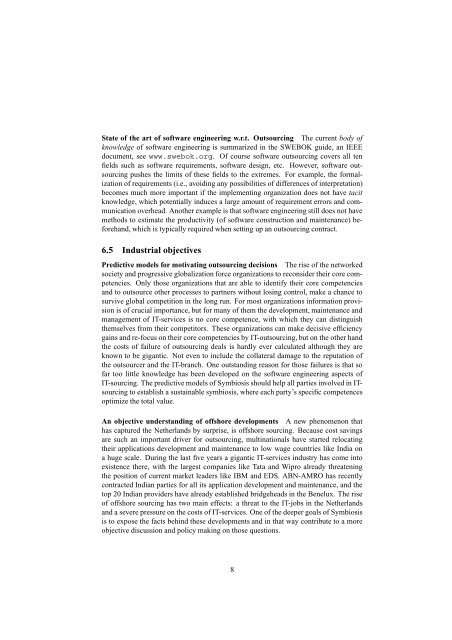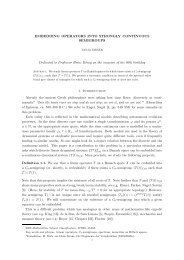Symbiosis - Universiteit van Amsterdam
Symbiosis - Universiteit van Amsterdam
Symbiosis - Universiteit van Amsterdam
You also want an ePaper? Increase the reach of your titles
YUMPU automatically turns print PDFs into web optimized ePapers that Google loves.
State of the art of software engineering w.r.t. Outsourcing The current body of<br />
knowledge of software engineering is summarized in the SWEBOK guide, an IEEE<br />
document, see www.swebok.org. Of course software outsourcing covers all ten<br />
fields such as software requirements, software design, etc. However, software outsourcing<br />
pushes the limits of these fields to the extremes. For example, the formalization<br />
of requirements (i.e., avoiding any possibilities of differences of interpretation)<br />
becomes much more important if the implementing organization does not have tacit<br />
knowledge, which potentially induces a large amount of requirement errors and communication<br />
overhead. Another example is that software engineering still does not have<br />
methods to estimate the productivity (of software construction and maintenance) beforehand,<br />
which is typically required when setting up an outsourcing contract.<br />
6.5 Industrial objectives<br />
Predictive models for motivating outsourcing decisions The rise of the networked<br />
society and progressive globalization force organizations to reconsider their core competencies.<br />
Only those organizations that are able to identify their core competencies<br />
and to outsource other processes to partners without losing control, make a chance to<br />
survive global competition in the long run. For most organizations information provision<br />
is of crucial importance, but for many of them the development, maintenance and<br />
management of IT-services is no core competence, with which they can distinguish<br />
themselves from their competitors. These organizations can make decisive efficiency<br />
gains and re-focus on their core competencies by IT-outsourcing, but on the other hand<br />
the costs of failure of outsourcing deals is hardly ever calculated although they are<br />
known to be gigantic. Not even to include the collateral damage to the reputation of<br />
the outsourcer and the IT-branch. One outstanding reason for those failures is that so<br />
far too little knowledge has been developed on the software engineering aspects of<br />
IT-sourcing. The predictive models of <strong>Symbiosis</strong> should help all parties involved in ITsourcing<br />
to establish a sustainable symbiosis, where each party’s specific competences<br />
optimize the total value.<br />
An objective understanding of offshore developments A new phenomenon that<br />
has captured the Netherlands by surprise, is offshore sourcing. Because cost savings<br />
are such an important driver for outsourcing, multinationals have started relocating<br />
their applications development and maintenance to low wage countries like India on<br />
a huge scale. During the last five years a gigantic IT-services industry has come into<br />
existence there, with the largest companies like Tata and Wipro already threatening<br />
the position of current market leaders like IBM and EDS. ABN-AMRO has recently<br />
contracted Indian parties for all its application development and maintenance, and the<br />
top 20 Indian providers have already established bridgeheads in the Benelux. The rise<br />
of offshore sourcing has two main effects: a threat to the IT-jobs in the Netherlands<br />
and a severe pressure on the costs of IT-services. One of the deeper goals of <strong>Symbiosis</strong><br />
is to expose the facts behind these developments and in that way contribute to a more<br />
objective discussion and policy making on those questions.<br />
8

















